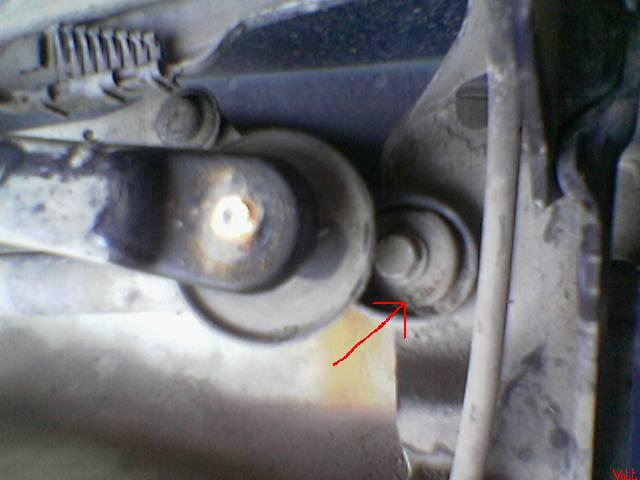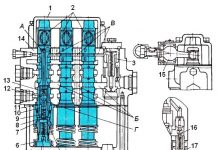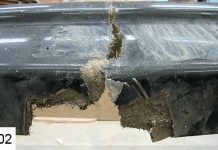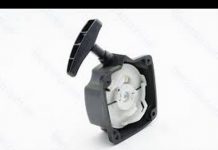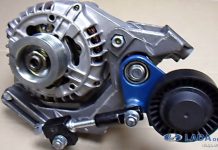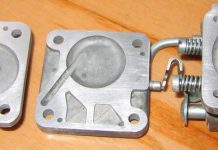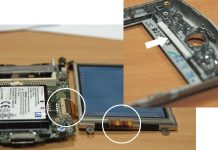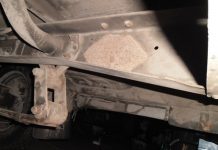In detail: do-it-yourself Renault Symbol engine repair from a real master for the site my.housecope.com.
- plugs on the ends of the camshafts;
- hole plug of the TDC position lock.
2. Install the camshafts with the grooves down as shown in the figure below.
4. Rotate the engine crankshaft counterclockwise (from the timing side) until the crankshaft rests against the TDC pin.
The grooves at the ends of the camshafts must be horizontal and offset downward relative to the axis, as shown in the figure.
5. Fit the flywheel locking tool (Mot. 582-01).
- crankshaft pulley to drive auxiliary equipment;
- the middle cover of the gas distribution mechanism drive (1);
- the top cover of the timing mechanism drive (2).
7. Unscrew the nut (3) on the idler pulley.
8. Remove the idler using tool Mot. 1368.
- timing belt;
- the camshaft pulleys using tool Mot. 1490.
10. Remove the parts shown in Figures 1-12. - Undo the bolts securing the air filter housing and remove the air filter housing.
- Remove the two bolts securing the throttle body and remove the air intake manifold.
- Remove the ignition coils.
- Unscrew the 24 bolts securing the cylinder head cover and then, tapping with a copper hammer on the projections (1), remove the cylinder head cover vertically upwards.
- Remove the intake and exhaust camshafts.
- Remove the rocker arms and hydraulic pushers. Caution: Place the hydraulic pushers in a vertical position to prevent oil leakage from them.
| Video (click to play). |
- Remove the two catalytic converter brace mounting bolts and remove the catalytic converter brace (see Fig. 8).
- Using tool Mot. 1495 remove the oxygen sensor; remove the exhaust manifold heat shields and the inner timing case spacer (see Fig. 8).
Remove the detachable part of the cooling jacket at the end of the cylinder head.
Remove the gas distribution rail.
Unscrew the 10 cylinder head bolts evenly, in several passes in the sequence shown in the figure. Remove the cylinder head and cylinder head gasket.
11. Using a valve puller, compress the valve springs.
- upper plates of valve springs;
- valve guide valve stem seals using pliers Mot. 1335.
13. Remove the casing and clutch disc.
Caution: To avoid cracks in the connecting rods, do not use a center punch to mark the lower end caps relative to the connecting rods. Use a permanent marker for this purpose.
Remove the crankshaft bearing caps (numbered 1 through 5).
Note: It is very important to mark the position of the crankshaft bushings, as they may be in different size groups for each bearing.
Removing the nozzles for cooling the piston crowns
1. Reamer the piston crown cooling nozzles (1) with a 7 mm drill.
Attention: Do not remove the ball (3) in order to
no chips have entered the oil channel.
3. Remove metal filings with a brush.
4. Screw the tool (1) (Mot. 1485 or Mot. 1485-01) into the injectors using a 6 mm Allen key (the wrench must be inserted into the tool).
5. Screw the inertia puller (1) (Emb. 880) onto the tool (Mot. 1485 or Mot. 1485-01).
It is very important not to allow damage (scratches, scoring) on the mating surfaces of aluminum parts.
Use Decapjoint's special solvent to remove old gasket residues from the surface.
Apply this solvent to the area to be cleaned, wait about 10 minutes, and then remove the remaining gasket with a wooden trowel.
1. The camshafts are identified by the markings (A).
Details of labeling (A): - labels (B) and (C) are for the supplier only;
- the label (D) serves to identify the camshafts:
AM - intake camshaft; EM is the exhaust camshaft.
Axial clearance. 0.08 - 0.178 mm
Intake valves. 40.661 ± 0.03 mm
Exhaust valves. 40.038 ± 0.03 mm
2. Identification by the position of the cams. - Intake camshaft. Position groove 3 on the end of the camshaft horizontally and downward. Cams 1 of cylinder 1 should be to the left of vertical axis 2.
- Exhaust camshaft. Position groove 3 at the end of the horizontal camshaft and with an offset downward. Cams 2 of cylinder # 1 must be to the right of vertical axis 1.
Table. Diameter of the camshaft bearings in the cylinder head.
Flywheel side
Checking the diameters of the camshaft bearings in the cylinder head.
Table. Diameter of the camshaft journals.
Flywheel side
A 4 -1 = Cylinder 4 inlet valve and cam # 1. E 4 -1 = Cylinder 4 outlet valve and cam # 1.
Checking the axial play of the camshaft
- camshafts in the correct position;
- cylinder head cover; tighten the bolts of its fastening (for the order and tightening torques, see the table “Tightening order of the cylinder head cover bolts”).
Check the axial play, which should be between 0.08 - 0.178 mm.
Checking the diameters of the bearing journals of the camshafts.
Table. The order of tightening the bolts of the cylinder head cover.
Bolt Tightening Sequence
Bolt Loose Sequence
1 to 12, 14 to 19, 21 to 24
Note: Use tool Mot. 588 and secure it with the oil sump mounting bolts (1) and bushings (2) with the following dimensions:
- diameter of the hole for the bolt (1) 9 mm;
Remove the cylinder head cover and camshafts again.
Cylinder head gasket
The thickness of the cylinder head gasket is measured at point (A).
Thickness of cylinder head gasket: Thickness of new
sealing gasket. 0.96 ± 0.06 mm
Crimped spacer thickness. 0.93 ± 0.06 mm
Height "H" of the cylinder head. 137 mm
Allowable non-flatness of the mating
cylinder head surface. 0.05mm
No regrinding of the mating surface is allowed.
Check the cylinder head for possible cracks.
Tightening torques for spark plugs. 25 - 30 Nm
Check the flatness of the mating plane with a straight edge and a set of feelers.
Permissible non-flatness of the cylinder block mating surface. 0.03 mm
No regrinding of the mating surface is allowed.
This engine is equipped with hydraulic lifters (A) and single-arm roller levers (B).
Rod diameter “d” (measured at distance “X1”):
X1 (intake valve). 75.14 ± 0.35 mm
Inlet valve. 5.484 ± 0.01 mm
X1 (exhaust valve). 77.5 ± 0.35 mm
Exhaust valve. 5.473 ± 0.01 mm
Inlet valve. 32.7 ± 0.12 mm
Exhaust valve. 27.96 ± 0.12 mm
Intake and exhaust valves. 90 ° 15 ′
Exhaust valve. 107.64 mm
Seat angle a:
Intake and exhaust valves. 89 °
Chamfer width X:
Inlet valve. 1.3 +1.4 0 mm
Exhaust valve. 1.4 * 1 '3 about mm
Inlet valve. 33.542 ± 0.006 mm
Exhaust valve. 28.792 ± 0.006 mm
Valve guides
Intake and exhaust valves. 40.5 ± 0.15 mm
Guide bush outer diameter:
Intake and exhaust valves. 11 +0.068 +0.05 mm
Guide bush inner diameter: Inlet and outlet valves:
Not processed. 5 +0, 075 0 mm
Processed *. 5.5 +0.018 0 mm
* The hole in the guide sleeve is deployed to the specified size after the sleeve is pressed into the cylinder head. Diameter of the seat for the guide sleeve in the cylinder head:
Intake and exhaust valves. 11 mm
Valve stem seals (valve stem seals) are installed on the inlet and outlet valve guides, which simultaneously serve as lower supports for the valve springs. Inlet and outlet valve guide slope: Inlet valve. 63 ° 30 ′
Protrusion “A” of the intake and exhaust valve guides. 11 ± 0.15 mm
Checking the clearance between the rods and valve guides
There are two ways to check the clearance between the rods and the guide bushings of the caps.
Nominal clearance between guide bush and valve stem:
Inlet valve. 0.015 ± 0.048 mm
Exhaust valve. 0.029 ± 0.062 mm
1. Lift the valve head 25 mm, then measure the valve movement in the direction of the arrows at an angle of 90 ° to the camshaft axis with the indicator. Half of this will give the clearance between the stem and the valve guide.
2. Measure the diameter of the valve stem and the inner diameter of the guide bush.
To install the valve stem seals, use tool Mot. 1511.
Note: Do not lubricate valve stem seals with oil prior to installation.
Installing new valve stem seals
Insert the valve into the cylinder head.
Put on the tip Mot. 1511 on the valve stem (the inside diameter of the tip must be the same as the stem diameter).
Keep the valve pressed against the seat. Install the valve stem oil seal (not lubricated with oil) onto the tip
Press down on the valve stem seal until it comes off the tip, then remove the tip.
Install the tappet (1) onto the valve stem valve stem seal.
Note: The inside diameter of the tappet must match the diameter of the valve stem. In addition, the bottom of the tappet should partially rest against the valve stem valve stem seal, which serves as the bottom seat washer for the valve spring.
Replace the oil seal by tapping the top of the tappet with your palm until the valve stem contacts the cylinder head.
Repeat the above steps for all valves.
Check spring calibration.
Free length. 41.30 mm
Fully compressed length. 23.20 mm
Installing the timing belt
There is a good instruction here: https://my.housecope.com/wp-content/uploads/ext/2629/html/sborka-dvigatelya.html
Original part numbers:
Pump - 7700274330
Timing kit - 7701471974
Exhaust valves - 7701473354
Valve seals - 7700103938
Cylinder head gasket kit - 7701471886
Exhaust manifold gasket - 8200365915
Cylinder head bolt kit - 7701471373
The design feature of motors is that there are difficulties in self-service and repair of engines. The car operating instructions recommend changing only the engine oil yourself. Other work requires special equipment, tools and experience. However, it is possible to carry out some types of repair work on your own, and that's what we'll talk about.
Engine parts such as timing belts and auxiliary units, valve seals, pistons and piston rings have a certain resource. Spark plugs, fuel injectors, crankshaft oil seals and other powertrain parts. Any engine repair will require replacement of the head gaskets, oil pan and valve cover.
Power units with a volume of more than 2.5 liters are afraid of overheating of the motors, after which, in some cases, it will be necessary to change not only the gaskets, but also the deformed parts of the power unit. In order to fully develop the engine resource, you must carefully observe all the requirements for servicing the motors.
Not all car filling stations in the regions of the Russian Federation and many CIS countries are distinguished by the high quality of the fuel sold. Its poor quality leads to rapid coking of the piston rings, which leads to a loss of power and dynamic performance, so it will be useful to know how to decarbonize them.
De-carbonization means cleaning the combustion chamber from carbon deposits. This can be done in two ways:
- Mechanical removal requiring disassembly of the motor.
- Chemical cleaning of the combustion chamber.
The mechanical method is very laborious, since it will require a complete disassembly of the engine, chemical treatment of the combustion chamber is quite available for independent execution. It is usually carried out on the eve of an engine oil change. With gentle cleaning, the liquid is poured into the engine oil and after a run of about 200 km, the oil and filter are changed.
Rigid cleaning involves pouring cleaning fluid into the combustion chamber through the spark plug hole. After 12 hours, it is thrown away by turning the crankshaft with the starter. Changing the engine oil in this case is also required.
The car may have other breakdowns, however, we will talk about them on occasion.
Repair of the K4J engine on Renault Symbol (1st part)
Lapping new valves.
There is a good instruction here: my.housecope.com/wp-content/uploads/ext/2629/html/sborka-dvigatelya.html
Original part numbers:
Pump - 7700274330
Timing kit - 7701471974
Exhaust valves - 7701473354
Valve seals - 7700103938
Cylinder head gasket kit - 7701471886
Exhaust manifold gasket - 8200365915
Cylinder head bolt kit - 7701471373
My timing belt broke, and the valves bent because of this.
Then the head has not yet been disassembled, it is not clear what is with the seats / guides and in what condition the pistons.
I am tormented by the question, if everything is slightly broken there, limit yourself only to replacing the valves, timing and pump, or is it better to look for a used head entirely ?!
Renault Simbol 2006 16 cl.





It's been a year since the bulkhead. I have driven 50 thousand since that time. The engine runs like clockwork.


Yes, this is understandable, some people just tell me that after the engine bulkhead and the cap. repair, it may not work correctly and fly again, and more than once. And that it is better to change the head entirely.





I also asked this question when the trouble happened, but only the "autopsy" will show the truth. In any case, the machine is still real estate, and in any case it needs to be disassembled, either for repair or for head replacement. And when you figure it out, then it will already be clear which is easier and which is cheaper.

hi, please tell me how you removed the valve stem seals.





I kept putting on new caps, so I didn’t regret the old ones. I picked out what I have to do :))

The grooves (counter bores) on the pistons are needed to bypass the valves during operation; when they are cut off, there is little sense from them.

Thank you, great video. Well done for telling the theory. Very helpful. Class. Thank you.





And why does the engine start worse each time? I changed the spark plugs, changed the fuel filter, checked the mesh filter for the fuel pump - clean, gasoline filled with 95, new oil, oil filter changed. It remains only to rinse the nozzles. Are there any other reasons why the engine is difficult to start?





Aleksey McOurin, my annual insurance has not ended yet.





I found the reason. Clogged throttle clearance. Washed. Now it starts up quietly and immediately. After being sealed with a red gasoline-resistant sealant, the tank no longer flows. For the cover, a puller was assembled from fasteners.

Den A sell it and buy another.





I'll try when I have spent the floor of the tank, it is already normal to seal it for a day without turning on the gas pump.





Somewhere from under the cover of the fuel pump pours. Replaced the cover with a sealing rubber. At the same time, I went through the thread with a sealant, just in case. After half an hour of torment, the lid finally twisted along the thread, and did not jump off it. You can tell from her when she spins to the end. I waited until the sealant dries up a little and went to my yard. And I have an entrance to the courtyard at a 45-degree slope and parking at an angle. I decided to see if it was dry there or not.It leaked around the lid and squeezed out the sealant. I pumped it out and tightened it almost one more turn. The lid does not go further, but it seems to have stopped flowing (perhaps the gasoline level is already lower).

Excellent, but in too much detail, those who will change the valves themselves and so know it. And those who don't know watch more academic videos. What is the mileage? And the reason for the belt break?





Mileage 170 thousand. And the reason for the belt rupture is burned parts. I bought the original timing kit, the tension roller turned out to be with an imperceptible defect, the belt began to pull to the side, because of this it frayed and broke. Traveled a little over a week.


The instructions say “tightened with a torque of 20 Nm, then turn all the bolts by 240 ° ± 6 ° in the same order” and you did 60 N. meter. Where is it written.? I also bent the valve and I don't know how to tighten the cylinder head







I did so at first, but 20 Nm is a very small effort. And when it reached 240 degrees, it felt like there was still twisting and twisting, and almost by hand. According to the second instruction, when I was pulling 60 Nm, I made more than one full rotation of 360 degrees. I had new hairpins. So, see how it feels. In my case, 60 Nm was just right. Less was definitely not an option. And if you do it too little, it will be very bad. The oil and antifreeze will start to mix, and worse, they will start to get into the cylinders. Plus, the cylinder head gasket may burn out. So, as the saying goes, “it's better to overbid than to underboot")))
Read about the parsing of the Renault Symbol - see here. Videos and reviews on the maintenance and repair of a car with your own hands.
How to repair a car with your own hands at home. We will help ourselves to repair and repair the car ourselves. We know how to restore a car with minimal investment. I attach a video instruction.
Category: DIY repair
Posted by Admin: at Axel's request
Review of the car owner: - Excellent value for money. A practical car, no show-off, but at the same time its face is not as terrible as that of Logan. - good basic equipment, full-size spare wheel - large trunk - starts up well in cold weather (very good for Siberia) - comfortable driver's seat, instruments and the switches are all at hand, the legs are not cramped, there is nothing to rest against them.
Renault Clio Symbol / Symbol with petrol engines: К4J 1.4 l 16V (1390 cm³) 98 hp / 72 kW and K7J 1.4 l 8V (1390 cm³) 75 hp / 55 kW; Operation manual, maintenance and repair, complete technical specifications, wiring diagrams, body control dimensions, diagnostics, repair. Renault Symbol Clio of the first generation with sedan bodies of the model of release from 2000 to 2008 (before and after restyling)
Video Renault Clio Symbol timing belt condition check, cabin filter installation and replacement (Renault Symbol Clio 00-08)
PETROL INJECTION SYSTEM
Adaptive engine idle speed correction
PRINCIPLE:
During normal hot engine operation, the throttle cycle at idle will fluctuate between the high and low limit values to achieve rated idle speed. It may happen that due to the scatter of performance indicators (running-in, engine contamination, etc.), the value of the degree of cyclic opening of the throttle valve at idle speed will be close to the upper or lower limit. Adaptive Idle Throttle Cycle Correction compensates for slow changes in engine air demand. This correction is made only if the coolant temperature is above 80 ° C, 20 seconds have elapsed after starting the engine and the engine is in the nominal idle speed correction mode.
The manual provides a step-by-step description of the operation, repair and maintenance procedures for RENAULT CLIO SYMBOL and SYMBOL cars from 2000 (before and after restyling) equipped with K7J (1.4 l, 8 valves) and K4J (1.4 l , 16 valves).When preparing the publication, all available materials were considered in order to provide the most complete information regarding the models supplied to the Russian market. The publication contains detailed information on the repair and adjustment of control system elements for gasoline engines (fuel injection and ignition), instructions for using the self-diagnosis system and recommendations for adjusting and repairing mechanical and automatic transmissions, brake system elements, steering and suspension. Detailed wiring diagrams for various equipment options are presented. Possible malfunctions and methods of their elimination, mating dimensions of the main parts and limits of their permissible wear, recommended lubricants and working fluids are given. The book is intended for car owners, service station personnel and repair shops.
Car operation Car maintenance Tips for car operation. Manual on operation and car repair Renault Symbol. Content.
Collection of manuals for the repair, operation and maintenance of Renault Symbol from 2001 to the present. DIY Renault Symbol repair.
Renault Symbol. Service and maintenance. Renault Symbol cars (Renault Symbol) General information about the car.
Removal and installation of the main brake cylinder. Interaction of cars with the air. Tell me when the working fluid in the Renault Symbol machine changes, which oil is better to use and in what volume? Renault Specifications Symbol.
Influence of body shape on aerodynamics. Renault Symbol Operation and Service. Removal and installation of the main brake cylinder. Gradually I will unsubscribe how things are. Removal and installation of the rear shock absorber. Fuels and lubricants and auto chemistry. Ignition switch and keys. The voice of Russian specialists who participated in determining the vehicle equipment levels and creating its interior was also significant.
Removal and installation of the clutch cable. And in the end - what is the most offensive. It will be quite comfortable and safe for grandchildren and granddaughters.
Renault Symbol (Logan) - Cylinder head repair and piston ring replacement (K7J)
Do-it-yourself Renault Symbol engine repair was found at your request - come here. Videos and reviews on the maintenance and repair of a car with your own hands. How to repair a car with your own hands at home. We will help ourselves to repair and repair the car ourselves. We know how to restore a car with minimal investment. I attach a video instruction.
Category: Car repair
Laughter in the subject: After 8 pm, the still unmade bed turns into an already disassembled one.
Posted by Admin: at Wolfgang's request
The car owner's assessment: 1. The dimensions are the same as those of a motorcycle. Between the rows in traffic jams I made my way calmly2. The correct weight / power ratio allows you to quickly accelerate and travel at a speed of up to 140 km / h3. A solid body, during a coup on the track, it did not even move the rack, but put it on the wheels, and went on. 4. Convenient layout, with the rear seats folded down, you can carry a refrigerator, or you can arrange a large double bed, well, whatever you like, I tried both options5. You will hit - and it's not a pity
Repair of the K4J engine on Renault Symbol (2nd part)
There is a good instruction here: https://my.housecope.com/wp-content/uploads/ext/2629/html/sborka-dvigatelya.html
Original part numbers:
Pump - 7700274330
Timing kit - 7701471974
Exhaust valves - 7701473354
Valve seals - 7700103938
Cylinder head gasket kit - 7701471886
Exhaust manifold gasket - 8200365915
Cylinder head bolt kit - 7701471373
Repair of the K4J engine on Renault Symbol (3rd part)
Installing the timing belt
Original part numbers:
Pump - 7700274330
Timing kit - 7701471974
Exhaust valves - 7701473354
Valve seals - 7700103938
Cylinder head gasket kit - 7701471886
Exhaust manifold gasket - 8200365915
Cylinder head bolt kit - 7701471373
Personal experience of repairing a Renault engine (K4M) when the timing belt breaks. Description of repair, replacement of valves, investigation of the causes of belt breakage, treatment options for a slipping timing belt. Tightening torques:
This video shows the entire procedure for replacing the rear wheel bearing on the Renault Symbol II
დამკვრელის სამართავი ღილაკების ჩვენება
- გამოქვეყნდა 17 თებ 2017-ში
- Repair of the K4J engine on Renault Symbol (2nd part)
There is a good instruction here: my.housecope.com/wp-content/uploads/ext/2629/html/sborka-dvigatelya.html
Original part numbers:
Pump - 7700274330
Timing kit - 7701471974
Exhaust valves - 7701473354
Valve seals - 7700103938
Cylinder head gasket kit - 7701471886
Exhaust manifold gasket - 8200365915
Cylinder head bolt kit - 7701471373 - Engine repairK4JRenault SymbolReno Symbol
Sem privet. Greetings from Turkiye.
Thank you, but in order to remove the inlet, you need to unscrew the studs on which the protection is held
It was not a question with my own hands :) I cannot remove the inlet, I unscrewed all the bolts, but I cannot remove it
and it seems to me that it is held by 2 studs on which the protection is screwed (injector ramps)
No. Everything was fine with her.
Well I went after assembly
Has been driving great for over a year
ANOTHER QUESTION WE HAVE A FINE CLEANING FILTER NEAR THE GAS TANK
Even I did not find this filter, probably everything is in the gas tank.
Do not know. I haven't climbed there yet
float rpm. flushed throttle. changed the O-rings. on the intake manifold replaced the gaskets. changed the candles. washed the idle sensor. everything exactly troit the arrow on the tachometer twitches. what could be?
EVERYTHING FOUND THE REASON FOR AIR SUPPLY THROUGH NOZZLES WHO WOULD KNOW.
and if you drown it how to do it?
somehow the choke fell out of the absorber, air began to suck in through it, and the revolutions also began to float. Somewhere, something can suck in air in the same way and the maf will give a command to the xx sensor, because of which the revolutions will float. This is one of the options. The absorber, if anything, is under the right headlight. A wire and a tube go to it.
they say stalemate needs to be taught the throttle
hello I want to clean the throttle. what keys are needed. number of heads.
Heads for 8, 10. But it is better to have the entire set of heads.
still a question some write like in the rain under the rugs the water gets into the salon. Did you have that? the carpet is dry under the rugs?
Ce forta de strangere ai folosit la strangerea chiuloasei
I cannot find a magazine on the repair and operation of this machine on the Internet. offered for money only. Where can I download the manual for this machine?
I didn't even search. All cars are the same plus or minus, so I didn't need any benefits
antifreeze must be drained before repair?
if the engine is disassembled, then of course you need
hi listen, and the gap is where the headlights and hood are, this is normal
you can look at the cilia on the headlights and there will be no gap
you also have such a gap
:)) For such a budget car, this is normal
but the truth is they say that she rides softly on our roads like a Toyota
well, the comfort of our basins, I think
🙂 I didn't think so. I didn't have a Toyota
what do you say is a good car worth taking? which is better engine 1.4 or 1.6.
I am in the Chekhov region. And in Moscow there are many ads
well, after 2113 pelvis the difference will be noticeable. and I think the salon is more than in 13-ke. and in what city do you live? I have a current problem there are few of them on sale. but I don't have them at all in Magnitogorsk. Only in the old body. I'm looking for them in all cities.
The car is very simple but reliable. Pleases the low cost of spare parts and consumables. The salon is small, but I'm not big either. Consumption for moderate driving 7 liters on the highway. The 1.4 engine is more than enough for me. The 170 rides calmly, accelerated to 200, but the engine speed is no longer comfortable. At the traffic lights it starts very briskly, but this is all due to the small weight of the car of 980 kg. The cabin is a little noisy, but it depends on what to compare. Everything under the hood is VERY compact, even the oil dipstick is very inconvenient to get out. Replacing belts and rollers is also not very easy because of this, but given the fact that the machine is reliable, this is a rare procedure. The main advantage of this car is its galvanized body. Associated with this is not a low purchase price. My car has 230 thousand mileage, but there is not even a hint of rust.
The lid and oil separator are best placed on an anaerobic sealant / adhesive - this is recommended by the manufacturer. Here is described and a photo of glue - Thank you for the video!
After servicing the intake manifold. when starting a cold engine -1100ob, warmed up 550ob. The tachometer needle floats in the range of approximately 0-30., 40 rpm (floats). Is that so nada? Or a symptom?
warmed up - 750 +/- 50 rpm
It’s some kind of ignition coil that can go awry.
Have you ever tried to improve the power and torque indicators?
It was necessary to record the sound of the motor before adjusting the valves, so that later it could be compared.
Why did he take it off? Sound engineer or what?
Good day, see the tank on video from Lviv and do you have a motor k j Trochi is not a standard power supply of gasoline? Bo in exchange for my kangaroo rozkhid just at once in a cosmic winter up to liters per km. Litom l per km. Dyakuyu for information.
The video has sound, howling, or a generator, or a gur pump, or a tension roller. At the very same problem, it disappears if you pour water or other liquids on the belt of the attachment, so it takes seconds. Who faced, how did they decide?
This strange sound is the work of the box. Diesel murmur. This is such a fig on all Logans.
The knock of the valves is practically inaudible. Some helpful hints http Aauhadullin. Ru regulirovki klapanov reno logan for adjusting Renault Logan valves
No gidrikas, simple as a bicycle, normal sound. Mine has already passed, without a capital, I only took off my head, on the third cylinder, the exhaust valve on the saddle drained the compression, cut it, rubbed it in and normally.
Yes, figs knows, I listened to a friend. V with a mileage in km, his engine works even louder. I have a mileage of km. In general, people write that the valves themselves are noisy. I do not know.
3. Engine General information Removal and installation of the power unit Procedure for disassembly and assembly of the engine Cylinder head General information Removal and installation of the cylinder head Dismantling, repair and assembly of the cylinder head Removal, installation and adjustment of the timing belt tension of the timing mechanism Removal and installation of camshafts Removal and installation of the oil pan Removal and installation of the oil pump Connecting rod-piston.
3.1. General information The car is equipped with a 4KM engine - gasoline, four-cylinder, four-stroke, in-line, with two overhead camshafts. It is placed at the front of the vehicle across its longitudinal axis. The camshafts are mounted on six journal bearings. The camshafts are driven from the crankshaft pulley by a toothed rubber belt, which also drives the water pump. The engine uses a closed crankcase ventilation system. Mas.
3.2. Removing and installing the power unit It is recommended to remove the power unit down with the subframe, after which, if necessary, you can disconnect the subframe and the gearbox. Removal procedure: - place the car on an overpass or lift; - disconnect the wires from the storage battery and remove it; - remove the front wheels and wheel arches; - remove the protective cover of the power unit; - drain the coolant by disconnecting the outlet hose from the radiator; - drain the oil from the gearbox; - if before.
3.3. The procedure for disassembling and assembling the engine Before disassembly, all auxiliary units and assemblies are removed from the engine, and only then it is completely disassembled. The procedure for removing auxiliary units is approximately as follows: - air conditioning compressor; - power steering pump; - generator assembled with a mounting bracket; - starter; - engine control system; - wiring harnesses; - intake and exhaust manifolds; - oil dipstick; - engine mountings; - a flywheel or faceplate (if equipped with an automat.
3.4.1 Cylinder head
3.4.2 General
3.4.3 Removal and installation of the cylinder head
3.4.4 Disassembly, repair and assembly of the cylinder head
3.4.5 Removal, installation and tension adjustment of the timing belt
3.4.6 Removal and installation of camshafts
3.4.7 Removing and installing the engine oil pan
.
3.5. Removal and installation of the oil pump Removal procedure: - remove the oil pan; Rice. 3.51. Unscrewing the bolts of the antifoam plate - unscrew the pump mounting bolts and the bolts of the antifoam plate in the engine crankcase (Fig. 3.51); - remove the anti-foaming plate; Rice. 3.52. Removing the oil pump from the engine crankcase - slightly turn the pump to free the pump sprocket from the drive chain, and remove the pump from the engine crankcase (Fig.
3.6.1 Connecting rod-piston group
3.6.2 Removal, disassembly and assembly
.
3.7.1 Crankshaft
3.7.2 Removal, inspection and installation
.
3.8.1 Cylinder block
3.8.2 Cleaning
3.8.3 Verification
.
3.9. Installing the piston group in the cylinder block It is assumed that the crankshaft is installed in the cylinder block before starting work. How to work: - clean the surface of the connecting rod bearings with a lint-free cloth. If new inserts are installed, rinse them with kerosene and wipe dry; - put the inserts in the connecting rod caps according to the previously made marks; - put the liners in the lower heads of the connecting rods according to the previously made marks; - lubricate the mirror of the engine cylinders, the pistons and piston rings are clean.
3.10.1 Cooling system
3.10.2 General
3.10.3 Cooling system operation
3.10.4 Changing the coolant
3.10.5 Removal and installation of the water pump
3.10.6 Removal and installation of the electric fan
3.10.7 Removal and installation of a radiator
3.10.8 Checking, removing and installing the coolant temperature sensor
3.10.9 Removal, check and installation of the thermostat
.
3.11.1 Lubrication system
3.11.2 General
3.11.3 Disassembly, inspection and assembly of the oil pump
.
3.12.1 Power system
3.12.2 General
3.12.3 Removing the fuel pressure in the injection system
3.12.4 Removal, installation and check of power system elements
.
3.13.1 System of reduction of toxicity of the fulfilled gases
3.13.2 General
3.13.3 Checking and replacing system components
.
3.14.1 Exhaust system
3.14.2 General
3.14.3 Removal and installation of system elements
3.14.4 Catalytic converter
.
| Video (click to play). |
3.15.1 Ignition system
3.15.2 General
3.15.3 Ignition system operation
3.15.4 Precautions when working with the ignition system
3.15.5 Removal and installation of ignition coils
3.15.6 Removal and installation of the knock sensor
.

